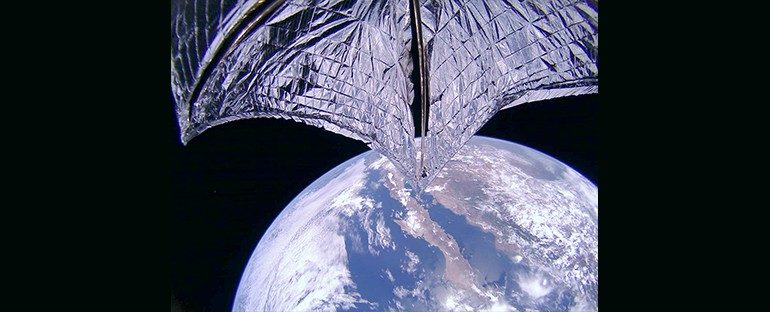Our blog series on solar sail technology commenced with a brief overview and introduction to solar sailing as well as the controlling mechanisms of sailcrafts followed by an investigation of the deployment of a spinning solar sail, its theoretical dynamics and its practical aspects. In this final post, we look more closely at some of the different sail satellites that have been deployed successfully.
- Interplanetary Kite-craft Accelerated by Radiation of the Sun (IKAROS)
- NanoSail-D2 and FeatherSail
- Cosmos-1 and LightSail-1
- Lightsail 2
The effect of solar radiation pressure was well known and was even used during the Mariner 10 mission. The solar radiation pressure was used to create a windmill torque to maintain the angular rate around its roll axis. The IKAROS satellite from JAXA was the only successful mission dedicated to solar sailing in the past. There are, however, other successful satellites that deploy drag sails including the NanoSail-D2 from NASA and LightSail. There are also several new sail satellites (solar sail and drag sail) that are close to being completed and will be launched soon.
1 Interplanetary Kite-craft Accelerated by Radiation of the Sun (IKAROS)
The Japan Aerospace Exploration Agency (JAXA) built and successfully launched the first solar sail – IKAROS satellite – into space. The goal of IKAROS was to explore a new and feasible solar electric sail technique using lightweight and extreme thin-film technology. This 200m2 spinning solar sail was launched in May 2010 and performed a fly-by of Venus in December 2010. The IKAROS utilised wire booms as masts to support the sail. The wire booms had tip masses that experienced sufficient centrifugal force owing to the constant spin, which in turn kept the wire boom stiff under operation. Thrusters were used to control the spin of the satellite. The deployment of the sail was, however, one of the main challenges. Many test deployments were executed to ensure that the deployment mechanism would be successful. These tests included a model launched by a sounding rocket and an experiment on a high-altitude balloon.
2 NanoSail-D2 and FeatherSail
The NanoSail-D project was a 3U CubeSat-sized sail spacecraft that deployed a 10m2 sail and utilised semi-rigid booms. The first NanoSail-D, which launched in August 2008, failed; however, the second satellite attempt, successfully launched on 19 November 2010 and had enough power to run full communications for three days. The NanoSail-D2 project did not use solar thrust but instead utilised aerodynamic drag to deorbit. This was the first successful in-orbit demonstration of a sail deployed by a CubeSat. The sail satellite had an orbit lifetime of eight months and re-entered the earth’s atmosphere on 17 September 2011. Building on the technological advancements of NanoSail-D, NASA a further advanced concept known as FeatherSail is under investigation by NASA.
3 Cosmos-1 and LightSail-1
The Planetary Society built the Cosmos-1 solar sail satellite in 2005. Its solar sail surface was made from individual blades and was launched from a Russian submarine. Cosmos-1 would have been the first satellite dedicated for solar sailing, but the mission was unsuccessful due to a rocket failure. LightSail-1 is a nanosatellite (a triple CubeSat configuration) similar to the NanoSail-D2. The LightSail-1 was the next solar sail satellite from The Planetary Society. It was intended to be one of three in the complete LightSail project with the LightSail-1 demonstrating the technology in earth-centred orbit.
4 Lightsail-2
LightSail-2® is a crowdfunded spacecraft project of the Planetary Society which set out to test solar sailing technology for CubeSats. On 31 July 2019, the Planetary Society announced the mission success of LightSail-2. This milestone means that LightSail 2 is the first spacecraft that used solar sailing for propulsion in Earth orbit, “the first small spacecraft to demonstrate solar sailing, and just the second-ever solar sail spacecraft to successfully fly, following Japan’s IKAROS, which launched in 2010”. Upon the successful completion of its mission, Lightsail-2 slowed down due to friction from Earth’s atmosphere whereafter it eventually burnt up in the atmosphere.
Solar sail satellites can deploy large structures in space and control their attitude to point the solar thrust in a certain direction. These capabilities are useful in several other applications that require a structure to be deployed. Some of these applications include the James Webb Space Telescope, space-based solar power, and deployable antennas.
Read the full series here:
Spinning solar sail: The deployment and control of a spinning solar sail satelite: https://www.ee.sun.ac.za/spinning-solar-sail-the-deployment-and-control-of-a-spinning-solar-sail-satelite/
An overview: The deployment of a spinning solar sail: https://www.ee.sun.ac.za/an-overview-the-deployment-of-a-spinning-solar-sail/








